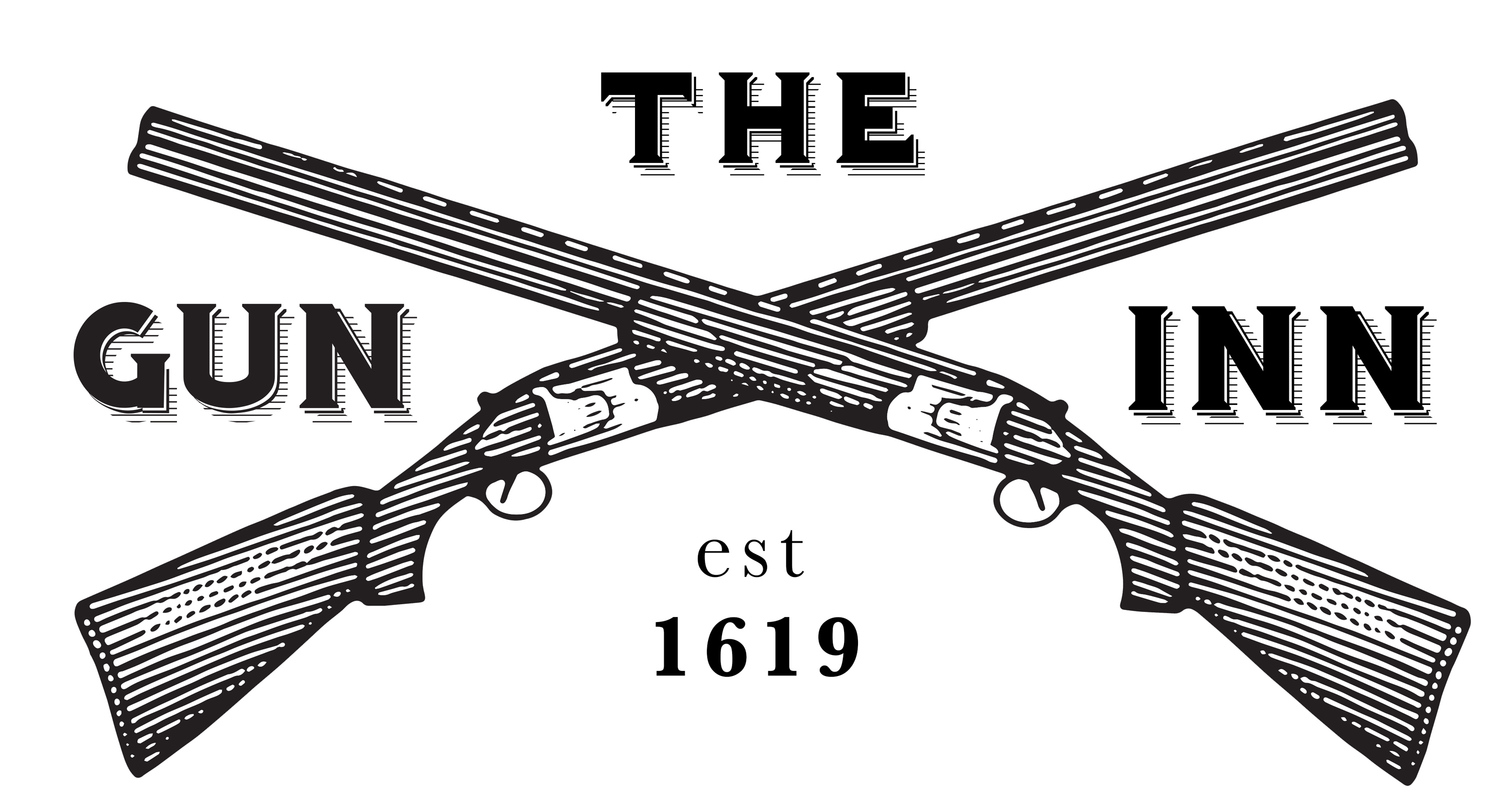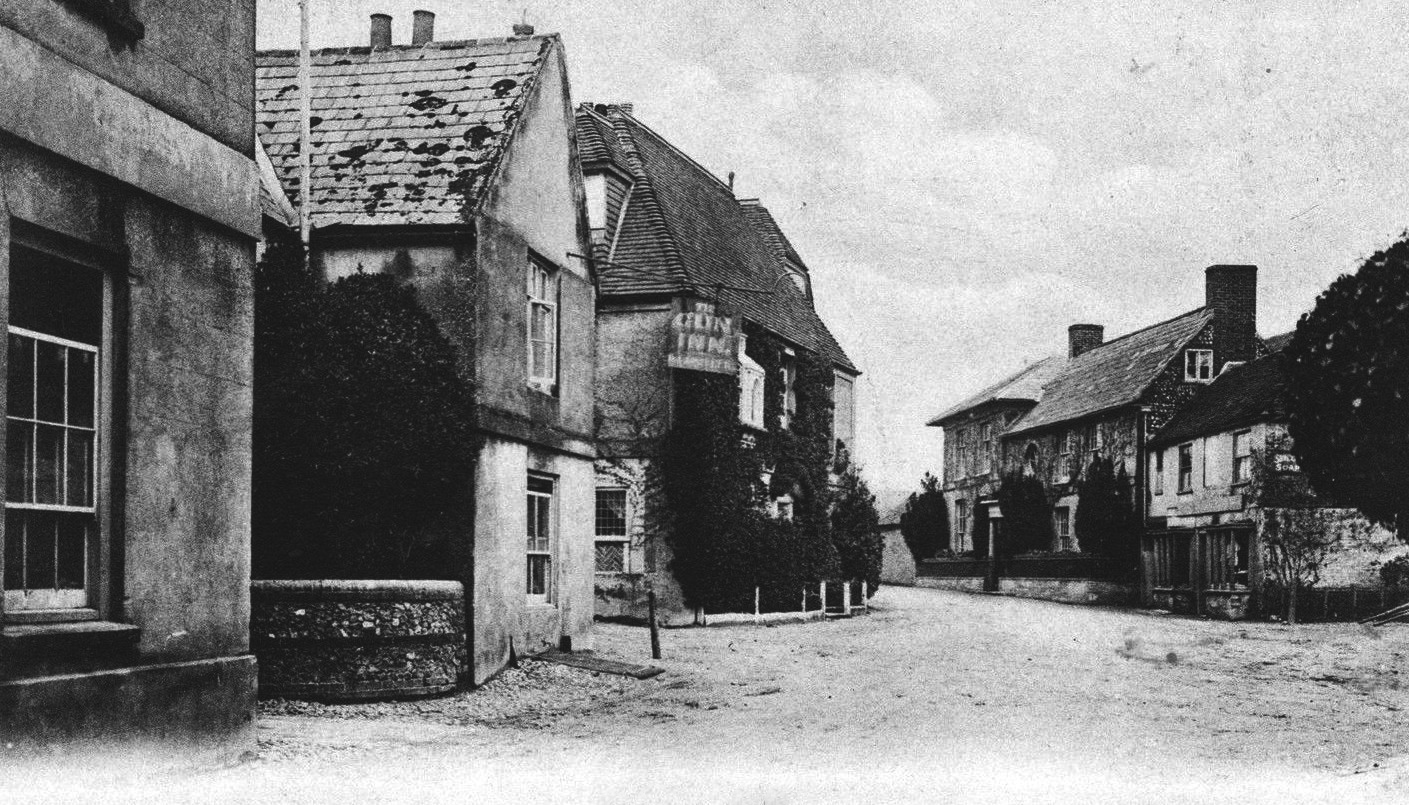Having stood on the corner of Findon's Square for approximately 500 years, the Gun Inn is steeped in local, national, and even international history, from the time of the Tudor dynasty, right up until the present day,
Origins.
In 1954, the Gun Inn was listed as a 'Grade II' building. The description that accompanies this listing describes the North Wing of the pub as 'a pre-1530 building with a three-bay crosswing'. The area described here currently includes the main bar area and the rooms above, and the passage behind, of which all is timber framed.
This is the most accurate dating I have been able to obtain so far. However, there is apparently evidence that the foundations and even some of the pub's current structure were part of an open medieval 'Hall House' with a cross-wing attached in the shape of a 'H' or a T'. This was essentially a house within which a large hall was the dominant feature, with extensions or wings added. If so, it could be estimated that the pub's origins date back to the late 1400s, potentially into the Plantagenet period.
Ian Mallender (see sources) suggests that it could have been built by a prosperous yeoman or merchant, following the Peasant's Revolt of 1381, in the aftermath of which wealth and therefore power was devolved from the monarchical nobility. This is due to it's smaller size in relation to other hall houses and lack of ornamentation. The village around this time began to move away from it's location around the Parish Church, to where it is situated today.
With regards to dating the pub via its structure, Mallender makes other notable observations. The jetty that extends above the long bar window that faces the High Street is a common feature of 15th/16th century hall buldings, due to the lower cost of short timbers for the upright supports, and the extra space that can be extracted from a smaller foundation.
He also notes that the supports within the roof structure are common to 15th century buildings; in-particular the curved or moulded tie-beams. They are typical of open ceiling construction in this period.
Image scanned from 'The Gun Inn At Findon'' by Ian Mallender, IMPRINT, Worthing, 2000.
Image scanned from 'The Gun Inn At Findon'' by Ian Mallender, IMPRINT, Worthing, 2000.
The above would suggest that the pub was a hall-house before being converted into it's long standing role as an Inn. This is most probably because Findon lies on a busy thoroughfare that runs east-west along the coastline, and also at a north-south gap in the downs, situated between Cissbury Ring, containing it's Iron Age hill fort, and Church Hill. As such the pub sits in a prime location as a stopover for travellers along the old roads between Arundel and Steyning.
As the taller amongst us may have noticed, the ceiling of the bar is very low (look out for the little ceramic ducks adorning the beams). It is estimated that in the early 1600s the ceiling was lowered to provide accommodation for the occupants and guests of the Inn.
'THE MUSKETTE GUNNE' IN THE 17TH CENTURY.
The majority of the Gun's history is known from the 1600s onwards. The landlord, Thomas Lasseter, fell victim to Sir Giles Mompesson, an MP, who put forward a scheme to charge innkeepers for licences from which he illegally benefited. The image below shows Sir' Giles' record of the sale of a licence to ''the Muskett Gunn'' of Findon on October 22nd, 1619.
Image scanned from 'The Gun Inn At Findon'' by Ian Mallender, IMPRINT, Worthing, 2000.
An initial ''fine'' or fee of £10 was demanded, with continuing payments twice yearly of five shillings. Nevertheless, In 1621 the rogue MP was forced to flee the country, yet James I, king at the time, saw the fiscal benefits of Giles' scheme and inn licences soon became law. The fact that the scheme was introduced in initially indicates two key things: Firstly, that The Gun was serving alcohol for many years prior to this date. Secondly, the pub was dealing a trade worth enough to be illegally taxed.
(It should be noted that above, the record above carries the name Thomas ''Leicester'', which was a corruption of Lassester, owing most probably to the varied spelling of the time, and perhaps a local accent.)
Why the gun inn?
As mentioned above, the proprietor in 1621 was a man named Thomas Leicester, and the pub was called 'The Muskette Gunne'.
The prosperity of the pub and it's facilities is made evident in a 1722 probate inventory, after the death of one William Lasseter, as seen below:
Image scanned from 'The Gun Inn At Findon'' by Ian Mallender, IMPRINT, Worthing, 2000.
It should be noted that the above is not the original document but a typing of the probate by Ian Mallender.
The probate reveals some interesting information about the pub; it brewed it's own beer and cider, it now had room to accommodate a substantial amount of guests, and most revealing of all, it also contained a gunsmiths shop. The mystery is solved, and explains why the pub now holds the name 'The Gun Inn'.
It has been confirmed that in 1693 'The Muskette Gunne' was owned by one William Lasseter, an indirect heir of the Thomas described above who did indeed live there and was also a gunsmith as well as an innkeeper.
THE GUN UNDER THE 'LASSETER' FAMILY
The Lasseter family is well established in the parish records, and have owned the inn through direct descendants up until 1798. This begins with the death of Thomas Lasseter in 1572, and extends through the subsequent generations including Robert Lasseter who died in 1612, Matias, one of his nine children, who died in 1695 leaving ten offspring of his own, and in 1701 the death of ''William Lasseter of The Gunn Inn'' is recorded. This is presumably the father of the William Lasseter whose probate is shown above.
'Ship's Timbers'
There have been many rumours surrounding the pub that the timbers used to frame it originally began life as part of a ship. This is untrue. The terminology derives from the The Royal Navy's ships of the period being described as having ''hearts of oak'' due to their oak timber frames. ''Ship's timber'' refers to the class of timber, not their previous usage.
Timber yards would pre-fabricate the frames of both building and ships to test their fit, and then rebuild these timbers on-site. The Roman numerals etched during this process, to ensure they were ordered correctly, can be seen by the long window in bar area, where a timber has been removed.
The diagram below documents these markings.
Image scanned from 'The Gun Inn At Findon'' by Ian Mallender, IMPRINT, Worthing, 2000.
The South Wing.
The south wing of the pub, which contains the current restaurant area and the private dining room is estimated to have been added onto the pub around the 18th century. This is evidenced by the genuine 'door case' - the décor that surrounds the door as the pub is entered via the garden. However, much refurbishment and refitting in the 20th century has altered the appearance of the 'South Wing'.
The Parish Well.
It was reported in 1773 in the diary of writer and naturalist Gilbert White that ''the parish well at Findon is 200 feet deep'', and was situated at the rear of the pub, under what now is the toilets, or at least the old public toilets. This well served as the villages fresh water supply until running water was introduced.
The Gun Gates.
The wrought-iron gates which can be seen in the side wall of the garden containing the letter 'G' do not abbreviate the word 'Gun'. They are the initials of George Goacher, who was innkeeper here between 1891 and 1907.
'Up the Glens!': The Gun Inn during The Second World War.
Findon is steeped in visible history from this period, ranging from the ruins of an old observation post that lie above Church Hill, to Cissbury Ring, which was used extensively by the Canadian army in the build up to D-Day. A meandering line of enormous 5ft concrete blocks ran from Church Hill - the foundations of which can still be seen - all the way to the south of Nepcote.
However, the Gun's own relationship to the war is far more specific. Officers of he Stormont, Dundas and Glengarry Highlanders, who trained on the Downs surrounding the village, and were quartered at Muntham court, decided to descend upon the Gun one wet evening in June 1943. Upon their arrival the barmaid, one Nelly Skinner, was reported to exclaim: ''My there are a lot of you Glens here tonight. Up the Glens!'''.
As explained on the plaque outside the pub that is dedicated to the regiment, It was reported that the cry ''Up the Glens'' that originated in the bar of the Gun, was heard in confrontations from D-Day right up until VE Day itself.
Sources:
In particular I am indebted to the following two sources. The first an excellent text by the late Ian Mallender who was instrumental in the success of 'The Save The Gun' campaign, which prevented this important village landmark from being transformed into housing. All the research they gathered during this campaign is presented in the following book.
Ian Mallender, The Gun Inn At Findon - Cissbury Solstice - and Other Short Pieces, IMPRINT, Worthing, 2000.
Another is Valerie Martin's website www.findonvillage.com which is an invaluable collection of information about Findon village and it's history.
Others include:




